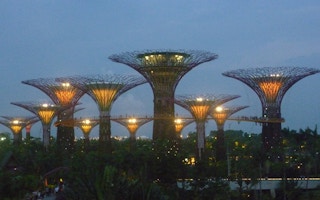The construction industry is scrambling to find sustainable building materials for Asia’s booming cities, and companies are now competing for industrial waste to replace some of the natural resources they consume, say experts.
In Singapore, the lack of natural resources and growing demand for green buildings are driving the hunt for alternative building materials, and several concrete manufacturers have turned to a limited supply of recycled materials and industrial by-products.
One manufacturer that has done so is Holcim Singapore, a subsidiary of the Swiss-headquartered Holcim Group.
“We look for win-win solutions that offer immediate value and provide a commercial advantage,” said managing director Sujit Ghosh in an interview at the firm’s recently opened Centre of Excellence.
Holcim established the new centre with support from Singapore’s Economic Development Board. Its aim is to take products at the research and development stage and turn them into commercial products saleable in Asian market.
Holcim is no stranger to using recycled materials in its products. In 2007, prompted by the sand crisis (see sidebar), Holcim started using waste collected from Singapore’s shipping industry in the making of its concrete. But first, it had to convince the regulator, Building and Construction Authority (BCA), that such material was safe enough to be allowed in building codes, noted Dr Ghosh.
The new concrete, called Holcim Green, was made from recycled granite from old buildings. Part of the sand needed in the process was also replaced with processed copper slag used by shipyards to clean ships.
Holcim obtained its copper slag by setting up a joint venture with local waste processing firm ecoWise in 2008, but the 400,000 tonnes that Singapore’s shipyards discard annually is only enough for about one month of the manufacturer’s concrete production.
The company produces about 1.5 million cubic metres of concrete each year, of which 5 to 10 per cent is certified green concrete.
Now that copper slag and other alternative materials- such as debris from building demolitions - have been approved by building regulators, competition for those resources is increasing, said Dr Ghosh.
The firm is currently finalizing plans to use waste materials from Singapore’s waste incinerators, known as incinerator bottom ash.
This waste, of up to half a million tonnes each year, would otherwise end up in the Republic’s only landfill. Semakau Landfill is located off-shore and is currently under expansion so that it can continue to receive waste through at least 2045.
Home-grown Samwoh Group, which specializes in road building and also makes certified green ready-mixed concrete, is another manufacturer recycling waste back into building supplies.
The firm has two plants in Singapore that recycle asphalt and concrete from construction projects. In 2010, it also built the Samwoh Eco-Green Building following a joint study with BCA and Singapore’s Nanyang Technological University to prove the safety of buildings using high percentages of recycled content. The building was the first in the region to use 100 per cent recycled ingredients for the concrete aggregate, which is the material added to cement and water to make the final product.
Read more about Samwoh’s green building materials.
A shortage of waste
Holcim’s Dr Ghosh said that if there was an unlimited supply of recycled materials and by-products, the industry could easily replace half of the virgin materials it consumes without affecting the quality of the concrete. However, the available supply of copper slag, construction debris and incinerator bottom ash combined provides only a fraction – about 10 per cent - of the material Singapore’s building industry needs for concrete, he noted.
“Asia is not going to decrease its insatiable demand to build, so we need to figure out how we can do more with less,” said Dr Ghosh.
To reduce the demand for concrete from the construction industry, Holcim developed an eco-friendly high strength concrete that can decrease the amount of material needed for building projects by up to 50 per cent.
Two years ago, Holcim again worked with BCA to amend building codes that allow the use of high strength concrete, which was already used in Europe and Japan.
Since then, the firm has seen increased interest from builders that want to lower their carbon footprint and increase available floor area by using less bulky concrete structures, noted Dr Ghosh.
He predicted that over the next five years, the company’s high strength concrete could grow to 20 to 30 per cent of its overall production now that BCA is encouraging the use of such materials to reduce the carbon footprint of buildings.
While green concrete and green building designs are important to reducing the building industry’s environmental impacts, they are only part of the solution, he said.
The industry has done a good job focusing on design and energy efficiency, but has only just begun to map out the overall environmental impacts of the construction process, he explained.
He has seen some progress, including growing emphasis on productivity and sustainable materials, and better sorting of demolition debris. Three years ago, contractors sent stones from demolition sites to the landfill with the rest of the debris, but now they are all reused, he noted.
However, Dr Ghosh said building developers will need a bigger push, possibly in the form of a carbon price, to fully address the impacts of a project from start to finish.

















